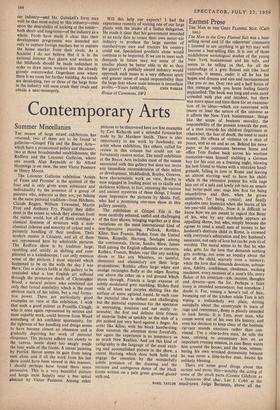Contemporary Arts
Summer Miscellanies
THE season of large mixed exhibitions has returned; two of them are to be found at galleries—Gimpel Fils and the Beaux Arts— which have a pronounced policy and character, two at those broadminded establishments, the Redfern and the Leicester Galleries, where one month Alan Reynolds or Sir Alfred Munnings is on view, the next Victor Pasmore or Henry Moore.
The Leicester Galleries exhibition 'Artists of Fame and Promise' is the quietest of the four and is only given some substance and individuality by the presence of a group of painters who, separate as they are, yet belong to the same pictorial tradition—lvon Hitchens, Claude Rogers, William Townsend, Martin Froy and Anthony Fry. Plainly they differ most in the extent to which they abstract from the visible world, but all of them ,combine a classical firmness of structure with a non- classical richness and sonority of colour and a painterly handling of their medium. Their modern master is Cezanne, and all of them are represented here by admirable pictures. The Redfern show is by tradition large, rambling and untidy, as shifting and com- plicated as a kaleidoscope. I can only mention some of the pictures I most enjoyed which happened to be on the walls the day I was there. One is always liable at this gallery to be reminded what a loss English art suffered through the premature death of Christopher Wood, a natural painter who combined not only that lyrical sensibility which is the most obvious mark of his talent, but a real forma- tive power. There are particularly good examples on view at this exhibition. I wish that such a good painter as Prunella Clough, who is once again represented by serious and most capable work, could borrow from Wood something of his confident spontaneity, for the tightness of her handling and design seems to have become almost an obsession and is gradually depriving her work of pictorial eloquence. The pictures adhere too closely to the canvas, nestle down too snugly inside the four walls of the frame. A recent painting by Patrick Heron seems to gain from being seen alone and if all the work from his last show could have been viewed in this manner. I should perhaps have found them more persuasive. This is a very beautiful picture and hangs most happily near a fine spiral abstract by Victor Pasmore. Among other pictures to be discovered here are fine examples by Ceri Richards and a splendid furnace-hot nude by Sir Matthew Smith. There is also opportunity to see work by Jawlensky, an artist whose exhibition, like others, called for review in this column but could not un- fortunately receive notice. The small exhibition at the Beaux Arts includes most of the names associated with this gallery but does not invite any 'immediate reconsideration of their talent or development. Middleditch, Bratby, Greaves, have characteristic work on view, Bratby, is now engaged in loading paint on to skulls and skeletons without, in fact, renewing the various and ancient mysteries of these things. I found most impressive the pictures by Sheila Fell, who had a promising one-man show in this gallery recently.
The exhibition at Gimpel Fils is the most carefully selected, useful and challenging of the four shows, bringing together as it does variations on the most international kind of non-figurative painting, Pollock, Rothko, Kline, Sam Francis, Bluhm from the United States, Riopelle, Hartung, Soulages among the continentals, Davie, Sandra Blow, James Hull among the English adherents or converts. Rothko, Francis, Bluhrn roar like any sucking doves or like any Whistlers, so tasteful, elemental and elementary are their large propositions; 'Rothko offers large white and orange rectangles fluffy at the edges floating one above the other on a red ground Which stares through, Francis a large expanse of subtly modulated grey marbling, Bluhm fluid veils of blues and purples shifting like the surface of some agitated liquid. In each case the pictorial idea is defiant and challenging but the pictorial experience for the spectator is enervating, precious and not easily re- newable; the first and definite little frisson Of surprise fades as quickly as the stab of a pin pushed not very hard against a finger. An artist like Kline, with his block handwriting. does summon the attention more forcefully, but again the experience is as temporary as so much New Realism. And yet this kind of calligraphy is the language of the most excit- ing and accomplished picture in the show.. a recent Hartung which does both hold and engage the attention by the wonderfully subtle precision of the drawing and the intricate and ambiguous dance of the black forms written on a pale green ground glazed with red.
BASIL TAYLOR


































 Previous page
Previous page